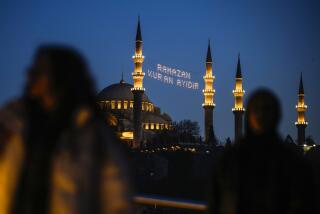Islam relic brings almost $1 million at Sotheby’s London
- Share via
WHAT: Several religions observe holy days this month. Today, we feature a relic from the world of Islam.
In an Arts of the Islamic World sale at Sotheby’s London earlier this year, a rare blue and white pottery pilgrim flask decorated with animals brought an astounding final sale price just short of $1 million. Presale estimate was about $84,000 to $112,000. Prices have been converted from GBP.
Iznik pottery, or ware, is named after the town of 0znik in western Anatolia where it was made in the 15th century through the 17th century. Tiles and pottery of the period are considered the high point of the Ottoman Empire.
The piece is thought to be the only surviving example of an Iznik ceramic in this flask shape. Variants were used by pilgrims to bring home oil, water or soil from visits to holy sites. Hence, pilgrim flask.
MORE: Formed in two halves before firing, the unusual form has one slightly convex side; the other is slightly concave. The spout and handles were added later. Imitated from metalwork flasks, the shape makes the flask easy to carry in two hands.
The early and unusual decoration is significant. The pattern, done in the early blue and turquoise of the period, shows a variety of fantasy birds and animals. Note the random placing: Creatures seem to run willy-nilly, chasing over the surface. This combination of unusual form and decoration gives a playful effect.
SMART COLLECTORS KNOW: With the coming of Islam in the 7th century, flasks became associated with the collection of Holy Zamzam water, from the well of Zamzam within the Masjid al-Haram, Mecca.
HOT TIP: An inventory number on the base indicates that it belonged to a known dealer and collector who died in the 1920s. It came to auction from a private collector in London. Chalk one up to provenance.
BOTTOM LINE: Smart collectors know that when the difference between estimate and sale result is this monumental, one of three things drove the disparity: Either bidders recognized the piece as highly significant (the coveted “sleeper” effect), or two or more bidders were determined. Another possibility is that, watching the market in Islamic art heat up, the buyer is banking on the future.
(c) 2018 TRIBUNE CONTENT AGENCY, LLC.
More to Read
Sign up for Essential California
The most important California stories and recommendations in your inbox every morning.
You may occasionally receive promotional content from the Los Angeles Times.




